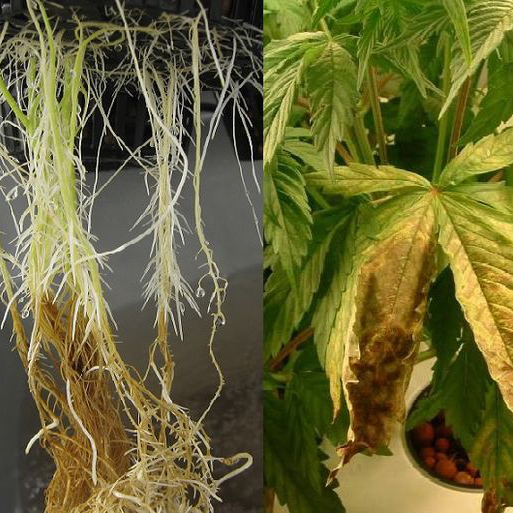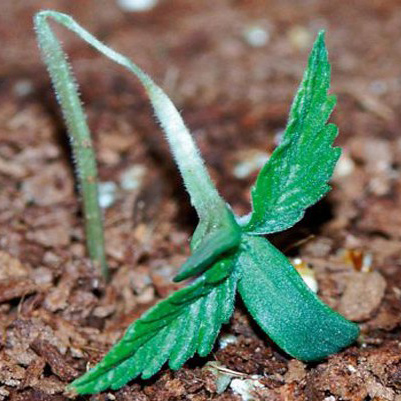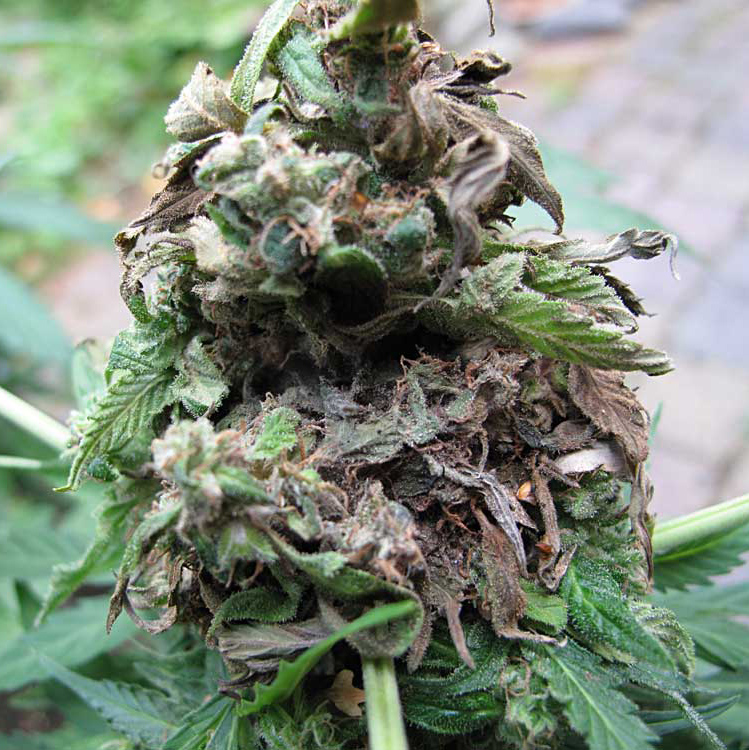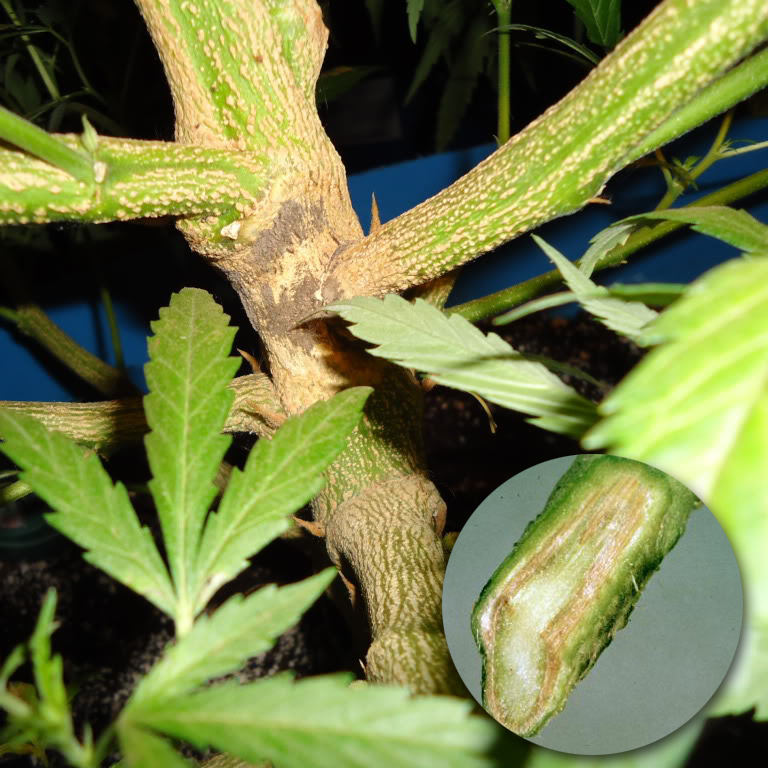Fungi & Diseases
Fungi reproduce by spreading microscopic spores through the air. Countless fungal spores are present in the air at all times. When these microscopic airborne spores find the proper conditions, they will settle, take hold, and start growing. Some fungi, such as grey bud mold (Botrytis) are so prolific that they can spread through an entire crop in a matter of days. Unsterile, soggy soil, coupled with humid, stagnant air, provides the perfect environment for most fungi to thrive. Although there are many different types of fungi, they are usually prevented with similar methods.
Prevention is the first step and the true key to fungi control. Cleanliness goes a long way in establishing a hostile growing environment and will help prevent fungal outbreaks. Washing down the grow room walls and floor with a 5% bleach solution is a good idea prior to bringing plants into the grow room. Circulating fresh air into and exhausting old stale air out of the grow room is very important. Failure to provide clean air will lead to disaster and crop failure. Using a oscillating fan(s) in the garden will keep the plants healthy by supplying with fresh air and CO2 to the leaves. Fungus grows poorly when the relative humidity of the grow room is kept below 40%.
If after taking all of the preventative measures, and fungi still appear, advanced control measures will need to be taken quickly. When fungi like powdery mildew appear on the leaf surfaces, this signifies that the disease permeates the entire plant and regular maintenance will be required for the rest of the growing season to keep it from spreading out of control. This will require regular spraying of all of the plants with some sort of fungicide. See the Indoor Gardening Basics page for organic fungicide recipes that work well in controlling fungi.
Powdery Mildew
First identification of infection is small spots on the top of leaves. At this point the disease has been inside the plant a week or more. Spots progress to a fine, pale, grey-whitish powdery coating on the growing shoots, leaves, and stems. Powdery mildew is not always limited to the upper surface of foliage. Growth slows, leaves yellow, and plants die as the disease advances. Occasionally fatal indoors, this disease is at its worst when roots dry out and foliage is moist. Plants are infected for weeks before they show the first signs.
Powdery mildew can be controlled by avoiding cool, damp, humid, dim grow room conditions. Low light levels and stale air promote this disease. Increase air circulation and ventilation, and make sure light intensity remains high. Remove affected foliage and increase airflow around plants by removing all foliage on branches for the first 6 inches from the stem outward. Also remove lower branches that aren’t receiving light. Getting air circulating through the plant’s branches will help greatly. And finally, begin a fungi control program by spraying the plants every 10 days with a neem fungicide or other organic fungicides that are safe for foods intended for ingestion. Learn more about Managing Powdery Mildew on Cannabis.
Root Rot
Root rot fungi cause roots to turn from a healthy white to a light brown. As the rot progresses, roots turn darker brown. Leaf chlorosis is followed by wilting of the older leaves and growth slows. When severe, rot progresses up to the base of the plant stem turning is dark. Root rot is most common when roots are deprived of oxygen and sit in soggy soil. Fungus gnats that cause damage to root hairs will encourage this disease unless they are eliminated early on with a regular watering with a gnatrol and water solution.
Using sterile growing mediums will help prevent the onset of root rot. Make sure that plants do not become nutrient deficient and pH levels are regularly monitored and kept in the correct range. Avoid soggy soils, this can be accomplished by weighing your soil filled containers prior to planting to establish a baseline. Then if you are uncertain if you are overwatering, you can weigh your watered containers/plants to see how much water is suspended within the medium and adjust your watering schedule as needed. After a short time you will be able to tell how much water is in your containers just by lifting them.
Downy Mildew
Downy mildew affects vegetative and flowering plants. Young succulent foliage is a favorite starting place. Downy mildew develops in temperatures below 76° F (26° C). It appears as whitish yellow spots on the tops of leaves creating pale and necrotic areas. On the undersides of leaves you will see the grey mycelium of downy mildew and if using a microscope you can sometimes see little red or yellow sap like structures that are the fruiting body of this fungus. This disease can spread very quickly, causing a lack of vigor and slow growth; leaves yellow, die back, and drop. The disease is in the plant system and grows outward. Downy mildew is often fatal. Avoid promoting the disease by not crowding plants, keep temperature above 76° F (26° C), and the relative humidity below 40% (30% humidity should be your target). If downy mildew is common in your area, use sterile mediums and destroy affected plants. Learn more about Managing Downy Mildew on Cannabis.
Damping Off (Pythium Wilt)
This fungal condition, sometimes called pythium wilt, is often found in soil and growing mediums. It prevents newly sprouted seeds from emerging, and attacks seedlings causing them to rot at the soil line, yellows foliage and rots older plants at the soil line. It occasionally attacks rooting cuttings at the soil line as well. It is caused by different fungal species, including Botrytis, Pythium, and Fusarium. Once initiated, damping off is fatal. At the onset of damping off, the stem loses girth at the soil line, weakens, then grows dark, and finally fluid circulation is cut, killing the seedling or cutting.
Excessive humidity, soggy soil and unsterile rooting mediums will cause damping off. Avoid these conditions by using a spray bottle to keep the soil surface moist and not saturated. Daily inspections and careful maintenance will be required. Using a light neem spray on the soil surface will help.
Grey Bud Mold (Botrytis)
Grey mold is the most common fungus that attacks indoor plants and flourishes in moist temperate climates common to many grow rooms. Botrytis damage is compounded by climates with a relative humidity above 50%. The disease starts within buds and is difficult to see. Initially it appears a whitish-greyish to a blueish-green in color. It appears hair like and similar to laundry lint. As the disease progresses, the foliage turns somewhat slimy and brown spots can appear. Grey mold spores are everywhere in nature. While most commonly found attacking the swelling flower buds, it also attacks stems, leaves, and seeds, causes damping off, and decomposes drying and stored buds. This disease is also transmitted via infected seeds.
Watch for single leaves within the flower clusters to dry out mysteriously. This can be a sign that grey mold is attacking the inner parts of the buds. Constant observation, especially during the last 2 weeks of flowering, is necessary to keep the disease out of the garden. Flower buds are quickly reduced to slime in cool, humid conditions or a sickly powder in warm dry rooms. Botrytis can destroy an entire crop in less than 10 days if left unchecked.
Keep relative humidity less than 50% in the grow room, keep fresh air circulating around the plants and exhaust stale humid air. Remove all affected plant materials and make sure to keep tools sterile. Increase the temperature within the grow room to around 80° F (26° C). Avoid crowding plants together and keep the light level bright. Spray plants with Gliocladium roseum and Trichoderma species. Avoid spraying plants near harvest.
Fusarium Wilt
Fusarium wilt is most common in warm grow rooms and greenhouses. Recirculating nutrient solutions above 75° F (24° C) creates perfect conditions for Fusarium. The water and nutrient solution carries this disease with it when contaminated. Fusarium starts as small spots on older, lower leaves. Interveinal chlorosis of the leaves appears swiftly. Leaf tips may curl before wilting and suddenly drying out. Portions of or the entire plant will wilt. The process happens so fast that yellow, dead leaves dangle from branches. This disease starts in the plants xylem, the base of the fluid transport system. Plants wilt when fungi plug the fluid flow in plant tissue. Cut one of the main stems in 2 and look for the telltale reddish brown color.
Use fresh, clean growing medium and avoid nitrogen over fertilization. Keep nutrient solutions below 75° F (24° C). Hydrogen peroxide infusions will also arrest fusarium. Always remove and destroy infested plants.







